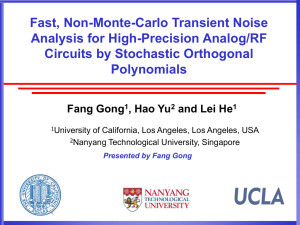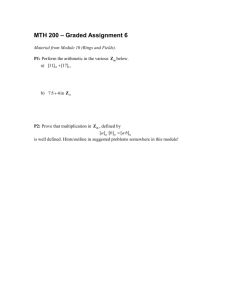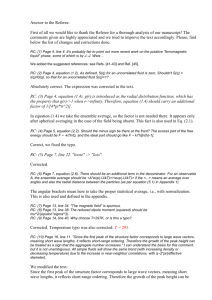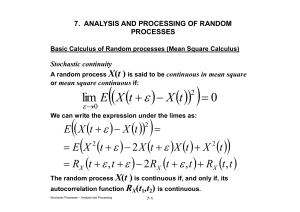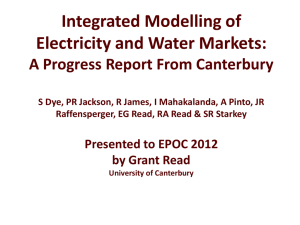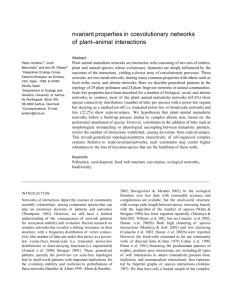Your Paper`s Title Starts Here:
advertisement
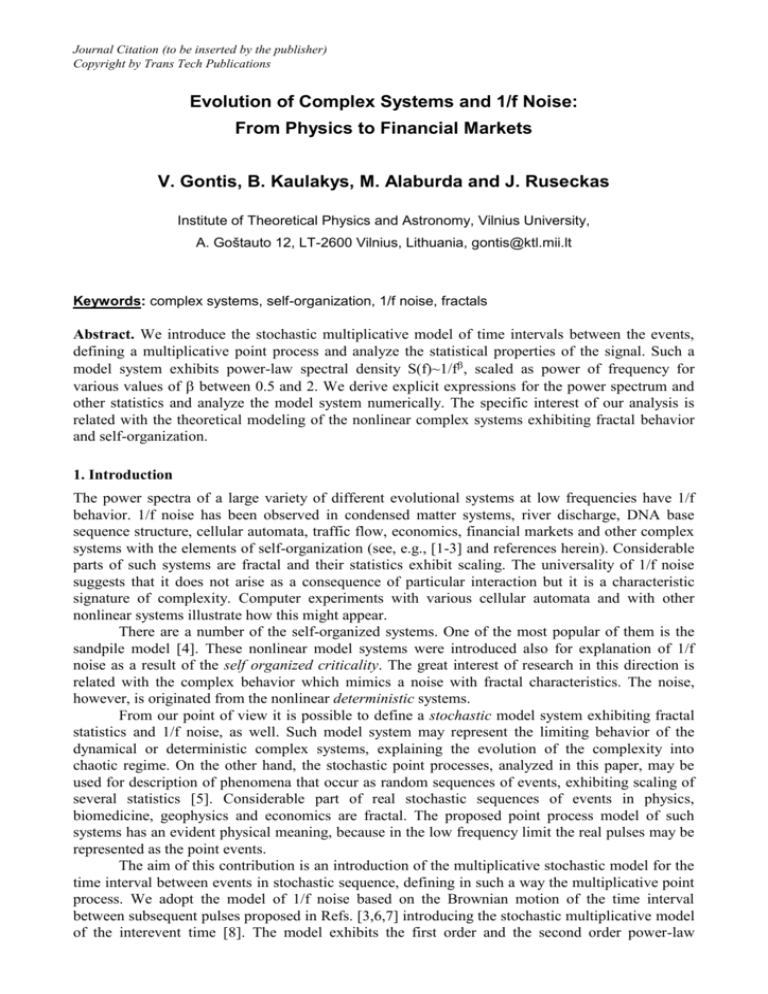
Journal Citation (to be inserted by the publisher)
Copyright by Trans Tech Publications
Evolution of Complex Systems and 1/f Noise:
From Physics to Financial Markets
V. Gontis, B. Kaulakys, M. Alaburda and J. Ruseckas
Institute of Theoretical Physics and Astronomy, Vilnius University,
A. Goštauto 12, LT-2600 Vilnius, Lithuania, gontis@ktl.mii.lt
Keywords: complex systems, self-organization, 1/f noise, fractals
Abstract. We introduce the stochastic multiplicative model of time intervals between the events,
defining a multiplicative point process and analyze the statistical properties of the signal. Such a
model system exhibits power-law spectral density S(f)~1/f, scaled as power of frequency for
various values of between 0.5 and 2. We derive explicit expressions for the power spectrum and
other statistics and analyze the model system numerically. The specific interest of our analysis is
related with the theoretical modeling of the nonlinear complex systems exhibiting fractal behavior
and self-organization.
1. Introduction
The power spectra of a large variety of different evolutional systems at low frequencies have 1/f
behavior. 1/f noise has been observed in condensed matter systems, river discharge, DNA base
sequence structure, cellular automata, traffic flow, economics, financial markets and other complex
systems with the elements of self-organization (see, e.g., [1-3] and references herein). Considerable
parts of such systems are fractal and their statistics exhibit scaling. The universality of 1/f noise
suggests that it does not arise as a consequence of particular interaction but it is a characteristic
signature of complexity. Computer experiments with various cellular automata and with other
nonlinear systems illustrate how this might appear.
There are a number of the self-organized systems. One of the most popular of them is the
sandpile model [4]. These nonlinear model systems were introduced also for explanation of 1/f
noise as a result of the self organized criticality. The great interest of research in this direction is
related with the complex behavior which mimics a noise with fractal characteristics. The noise,
however, is originated from the nonlinear deterministic systems.
From our point of view it is possible to define a stochastic model system exhibiting fractal
statistics and 1/f noise, as well. Such model system may represent the limiting behavior of the
dynamical or deterministic complex systems, explaining the evolution of the complexity into
chaotic regime. On the other hand, the stochastic point processes, analyzed in this paper, may be
used for description of phenomena that occur as random sequences of events, exhibiting scaling of
several statistics [5]. Considerable part of real stochastic sequences of events in physics,
biomedicine, geophysics and economics are fractal. The proposed point process model of such
systems has an evident physical meaning, because in the low frequency limit the real pulses may be
represented as the point events.
The aim of this contribution is an introduction of the multiplicative stochastic model for the
time interval between events in stochastic sequence, defining in such a way the multiplicative point
process. We adopt the model of 1/f noise based on the Brownian motion of the time interval
between subsequent pulses proposed in Refs. [3,6,7] introducing the stochastic multiplicative model
of the interevent time [8]. The model exhibits the first order and the second order power-law
2
Title of Publication (to be inserted by the publisher)
statistics and serves as the theoretical description of the empirical trading activity in the financial
markets [9].
Our specific interest is an analysis of the relation between the origin of the power-law
distributions and the power-law correlations. Obviously, the multiplicative point process can be
useful for the modeling of a wide variety of natural systems as well as of the processes in economics
and finance. We expect that the multiplicative point process can serve as a limiting theoretical
approach in the analysis of the nonlinear complex systems with the elements of self-organization
and for analysis of transition to the chaotic behavior.
2. Multiplicative point process
We consider a signal I (t ) as a sequence of the random correlated pulses
I (t ) ak (t tk )
(1)
k
where ak is a contribution to the signal of one pulse at the time moment t k , for example, a
contribution of one transaction to the financial data. When ak is a constant, the process (1) is
completely defined by the set of events {tk } or equivalently by the set of interevent intervals
{ k tk 1 tk } . Kaulakys and Meškauskas [3,6,7] showed analytically that the relatively slow
Brownian fluctuations of the interevent time k exhibited 1/ f fluctuations of the signal I (t ) .
Power spectral density of the signal (1) can be written as
2a 2 k max k max k
(2)
S ( f ) lim
exp(i2 f (k; q))
T
T k k min q k min k
where T is the observation time, (k ; q ) tk q tk is the difference of pulses occurrence times tk q
and t k , a denotes expectation of ak , while kmin and kmax are minimal and maximal values of index
k in the time interval of observation T .
We will study the multiplicative processes defined by the stochastic iterative equation
(3)
k 1 k k 2 1 k k .
Here the interevent time k fluctuates due to the external random perturbation by a sequence
of uncorrelated normally distributed random variable k with a zero expectation and unit variance,
denotes the standard deviation of the white noise and = 1 is a damping constant of the signal.
The diffusion described by Eq. (3) has to be restricted in some time interval min max .
Pure multiplicativity corresponds to the parameter 1 . Nevertheless, other values of
can produce power laws, as well, and the explicit expressions can be derived without the loss of
generality. The iterative relation (3) can be rewritten as a continuous Langevine stochastic
differential equation in k space
d
k 2 1 k k
(4)
dk
where kk (k k ) . The stationary solution of the corresponding Fokker-Plank equation with
a zero flow gives the long time probability distribution of in the space k
Pk ( ) C
where C has to be defined from the normalization
max
min
P( )d 1 and
(5)
2
2
2 .
3. Power spectral density and counting statistics
The power spectral density is a well-established measure of long-time correlations and is widely
used in stochastic systems. For the normal distribution of (k ; q) Eq. (2) takes the form
2a 2
S ( f ) lim
exp{i 2 f (k ; q) 2 2 f 2 2 (k ; q)}
T T
k ,q
where (k ; q) can be expressed from the solution of the multiplicative stochastic equation (4),
q
i
1 2 2 2
(k ; q) k exp(( )
i 1 j ) .
2
i 1
j 1
(6)
(7)
Averaging over the normal distributions of j yields the explicit expressions for the mean (k ; q)
and variance 2 (k ; q) ,
(k ; q) k q k 2 1q 2 ( 2 ) ,
2
2 (k ; q) k 2
(8)
2
q3 .
3
In the low frequency limit Eqs. (6) and (8) yield the power spectral density
(9)
2C a 2
32
(
)
Re exp( i( x ))erfc( ix ) x 32 2 dx.
(10)
4
(3 2 ) f f
x min
f 32
Here we introduce the scaled variable x
and is the expectation of k . For xmin 0
x max
1
S ( f )
and xmax Eq. (10) yields the explicit form of the power spectrum
1
(
)
2
C a
3 2
2 3 2
S ( f )
(
)
.
(11)
(3 2 ) f f
cos(
)
2(3 2 )
Eq. (11) proves that the multiplicative point process exhibits a general model of signals with the
power spectral density S ( f ) ~ f . The scaling exponent is
2 / 2 2
.
(12)
1
3 2
Numerical calculations confirm the validity of Eqs. (10), (11) and (12).
In the Fig. 1 and Fig. 2 we provide results of numerical calculations for the various values of
parameters. We suppose that this stochastic model with the parameters resulting in ; 1 can be
adopted for a wide variety of real systems.
Let us assume that a 1 and the signal I (t ) counts the transactions in financial markets. Then
the number of transactions in the selected time window d defined as N (t )
t d
I (t )dt measures
t
the trading activity. For the pure multiplicative model, 1 , Eqs. (7) and (8) define the relation
between N and . After substitution k
, q N and (k; q)
N N2 .
2
d
we get
d
(13)
Title of Publication (to be inserted by the publisher)
S(f)
4
10
4
10
3
10
2
10
1
10
0
=0.0018
10
-1
10
-2
10
1/f
0.84
1/f
1.14
1/f
1.51
=0.0025
=1
=0.05
=0.0030
-4
10
-3
10
f
-2
10
-1
10
0
S(f)
Fig. 1. Power spectral density vs frequency of the signal generated by the Eqs. (1), (2) and (3) with
the parameters 1, 0.05 and different relaxations of the signal . We restrict the diffusion
of the interevent time in the interval min 10 6 , max 1 with the reflective boundary condition at
min and transition to the white noise, k 1 max k , for k max .
10
4
10
3
=10
10
2
=2x10
10
1
10
0
10
=0.5
=0.02
-4
=3x10
-4
-4
1/f
0.83
1/f
1.00
1/f
1.20
-1
10
-4
10
-3
10
f
-2
10
-1
10
0
Fig. 2. The same as in Fig. 1 but for 0.5 , 0.02 and different parameters .
This relationship may be used for definition of the probability density function of N in a real
time from the relation Pt ( N )dN Pt ( )d ,
Ct d2
,
N = 1 ,
2
3
C (1 N )
N
Pt ( N ) t d
;
.
3
2
N 3 (1 N )3 Ct 2 ( d / ) , N ? 1
2
N 52
(14)
In the case of pure multiplicativity, 1 , the model has only one parameter, 2 / 2 ,
defining the scaling of the power spectral density, the power-law distributions of interevent time and
the counting number N . The model proposed with the adjusted parameter 2 / 2 nicely describes
the empirical power spectral density and the exponent of power-law distribution of the trading
activity N in the financial markets [10].
4. Conclusions
We introduce a multiplicative stochastic model for the time intervals between events of the process
seeking to define the variety of self-affine time series exhibiting the power-law spectra of different
slopes. Such a model of time series has only a few parameters. However, it defines the statistical
properties of the system, i.e., the power-law behavior of the distribution function and the scaled
power spectral density of the signal. Such power-law phenomena are observable in a large variety of
processes, from earthquakes to the financial time series. The proposed model relates and connects
the power-law correlations and the power-law distribution of the signal intensity into the consistent
theoretical approach. The generated time series are fractal since they exhibit jointly the power-law
probability distribution and the power-law autocorrelation of the signal. The ability of the model to
simulate 1/f noise as well as to reproduce signals with the values of power spectral density slope
between 0.5 and 2 promises wide applications of the model.
References
[1]
[2]
[3]
[4]
[5]
D. L. Gilden, T. Thornton and M. W. Mallon: Science, Vol. 267 (1995), p. 1837-1839.
H. Wong: Microel. Reliab. Vol. 43 (2003), p. 585-599.
B. Kaulakys and T. Meškauskas: Phys. Rev. E Vol. 58 (1998), p. 7013-7019.
S. Maslov, C. Tang, Y.-C. Zhang, Phys. Rev. Lett. Vol. 83 (1999), p. 2449-2452.
S. Thurner, S.B. Lowen, M.C. Feurstein, C. Heneghan, H.G. Feichtinger, M.C. Teich: Fractals
Vol. 5 (1997), p. 565-595.
[6] B. Kaulakys. and T. Meškauskas: Phys. Rev. E Vol. 58 (1998), p. 7013-7019.
[7] B. Kaulakys: Phys. Lett. A Vol. 257 (1999), p. 37-42.
[8] V. Gontis: Lithuanian J. Phys. Vol. 41 (2001), p. 551-555; cond-mat/0201514.
[9] V. Gontis: Nonl. Anal.: Model. Contr. Vol. 7 (2002), p. 43-54; cond-mat/0211317.
[10] V. Gontis and B. Kaulakys: cond-mat/0303089



